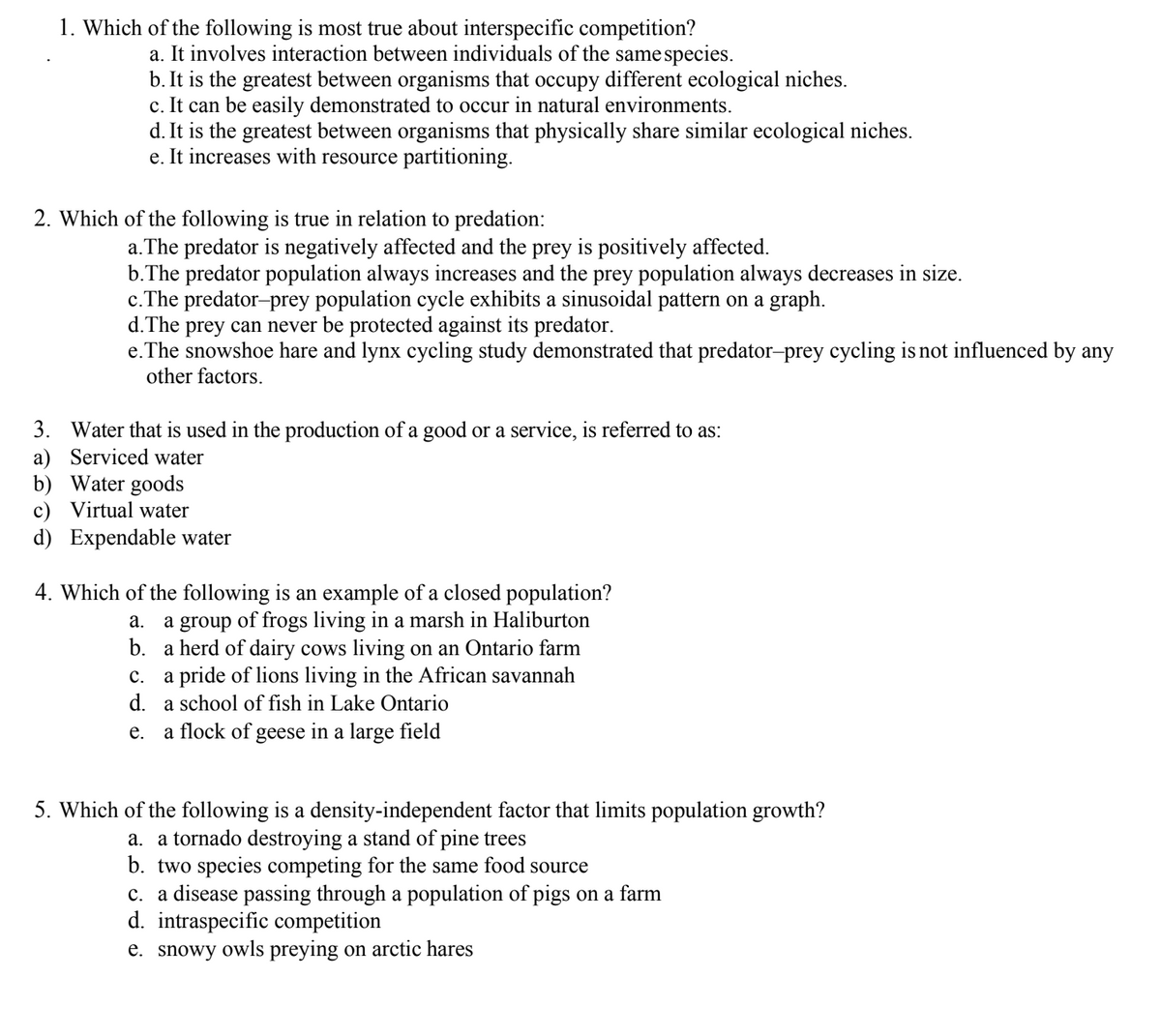a. It involves interaction between individuals of the same species. b. It is the greatest between organisms that occupy different ecological niches. c. It can be easily demonstrated to occur in natural environments. d. It is the greatest between organisms that physically share similar ecological niches. e. It increases with resource partitioning. 2. Which of the following is true in relation to predation: a. The predator is negatively affected and the prey is positively affected. b. The predator population always increases and the prey population always decreases in size. c. The predator-prey population cycle exhibits a sinusoidal pattern on a graph. d. The prey can never be protected against its predator. e. The snowshoe hare and lynx cycling study demonstrated that predator-prey cycling is not influenced by other factors. 3. Water that is used in the production of a good or a service, is referred to as: a) Serviced water b) Water goods c) Virtual water d) Expendable water
a. It involves interaction between individuals of the same species. b. It is the greatest between organisms that occupy different ecological niches. c. It can be easily demonstrated to occur in natural environments. d. It is the greatest between organisms that physically share similar ecological niches. e. It increases with resource partitioning. 2. Which of the following is true in relation to predation: a. The predator is negatively affected and the prey is positively affected. b. The predator population always increases and the prey population always decreases in size. c. The predator-prey population cycle exhibits a sinusoidal pattern on a graph. d. The prey can never be protected against its predator. e. The snowshoe hare and lynx cycling study demonstrated that predator-prey cycling is not influenced by other factors. 3. Water that is used in the production of a good or a service, is referred to as: a) Serviced water b) Water goods c) Virtual water d) Expendable water
Biology (MindTap Course List)
11th Edition
ISBN:9781337392938
Author:Eldra Solomon, Charles Martin, Diana W. Martin, Linda R. Berg
Publisher:Eldra Solomon, Charles Martin, Diana W. Martin, Linda R. Berg
Chapter54: Community Ecology
Section: Chapter Questions
Problem 11TYU: An ecologist studying several forest-dwelling, insect-eating bird species does not find any evidence...
Related questions
Question

Transcribed Image Text:1. Which of the following is most true about interspecific competition?
a. It involves interaction between individuals of the same species.
b. It is the greatest between organisms that occupy different ecological niches.
c. It can be easily demonstrated to occur in natural environments.
d. It is the greatest between organisms that physically share similar ecological niches.
e. It increases with resource partitioning.
2. Which of the following is true in relation to predation:
a. The predator is negatively affected and the prey is positively affected.
b. The predator population always increases and the prey population always decreases in size.
c. The predator-prey population cycle exhibits a sinusoidal pattern on a graph.
d. The prey can never be protected against its predator.
e. The snowshoe hare and lynx cycling study demonstrated that predator-prey cycling is not influenced by any
other factors.
3. Water that is used in the production of a good or a service, is referred to as:
a) Serviced water
b)
Water goods
c) Virtual water
d) Expendable water
4. Which of the following is an example of a closed population?
a. a group of frogs living in a marsh in Haliburton
b. a herd of dairy cows living on an Ontario farm
c. a pride of lions living in the African savannah
d. a school of fish in Lake Ontario
e. a flock of geese in a large field
5. Which of the following is a density-independent factor that limits population growth?
a. a tornado destroying a stand of pine trees
b. two species competing for the same food source
c. a disease passing through a population of pigs on a farm
d. intraspecific competition
e. snowy owls preying on arctic hares
Expert Solution
This question has been solved!
Explore an expertly crafted, step-by-step solution for a thorough understanding of key concepts.
Step by step
Solved in 2 steps

Knowledge Booster
Learn more about
Need a deep-dive on the concept behind this application? Look no further. Learn more about this topic, biology and related others by exploring similar questions and additional content below.Recommended textbooks for you

Biology (MindTap Course List)
Biology
ISBN:
9781337392938
Author:
Eldra Solomon, Charles Martin, Diana W. Martin, Linda R. Berg
Publisher:
Cengage Learning

Biology (MindTap Course List)
Biology
ISBN:
9781337392938
Author:
Eldra Solomon, Charles Martin, Diana W. Martin, Linda R. Berg
Publisher:
Cengage Learning